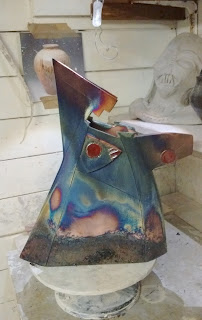It's been a long while since I've had any work to fire- probably the first batch since the summer. So it was with trepidation that I have begun some new Raku firings.
I've got a few commissions for people so this creates added pressure! At first the Copper matte results were a bit poor- a dodgy thermocouple meant that I was firing the kiln a tad low at around- 1020oc instead of between 1040-1050- which always seems to give better results and a better chance of achieving a good oxidation and reduction during the cooling process.
Once I had sussed this- and upped the temperature with the aid of a new thermocouple- the results have improved.
That said the pots have been interesting, with a lot of deep copper blue- some gold flashing and a bit of red. Though not much this time around. Oh well- keep on going maybe I will get it right one day soon! More post to follow I am sure.
I've got a few commissions for people so this creates added pressure! At first the Copper matte results were a bit poor- a dodgy thermocouple meant that I was firing the kiln a tad low at around- 1020oc instead of between 1040-1050- which always seems to give better results and a better chance of achieving a good oxidation and reduction during the cooling process.
Once I had sussed this- and upped the temperature with the aid of a new thermocouple- the results have improved.
That said the pots have been interesting, with a lot of deep copper blue- some gold flashing and a bit of red. Though not much this time around. Oh well- keep on going maybe I will get it right one day soon! More post to follow I am sure.





Comments
Post a Comment
Comments...